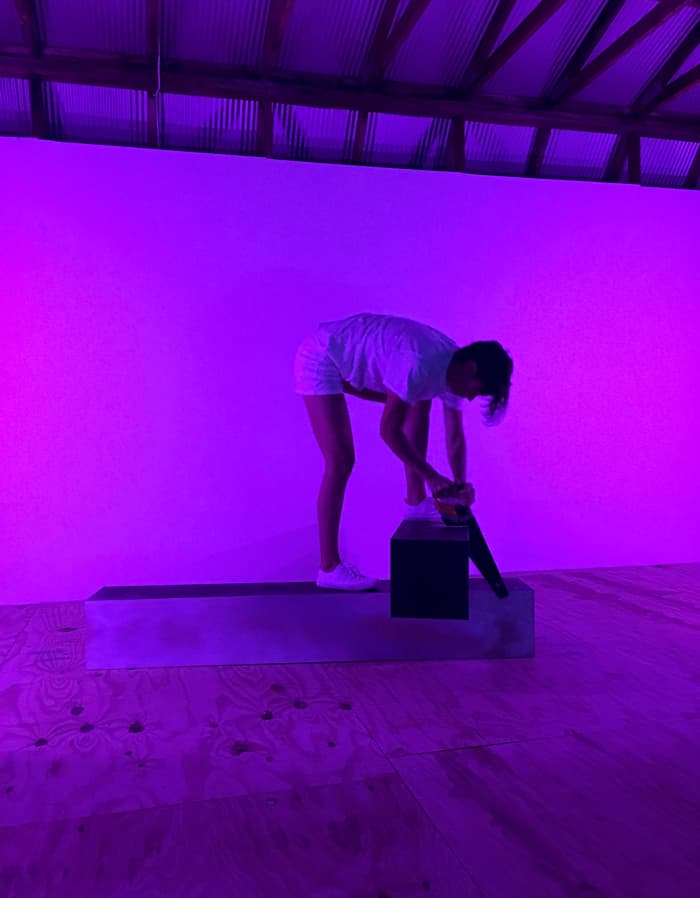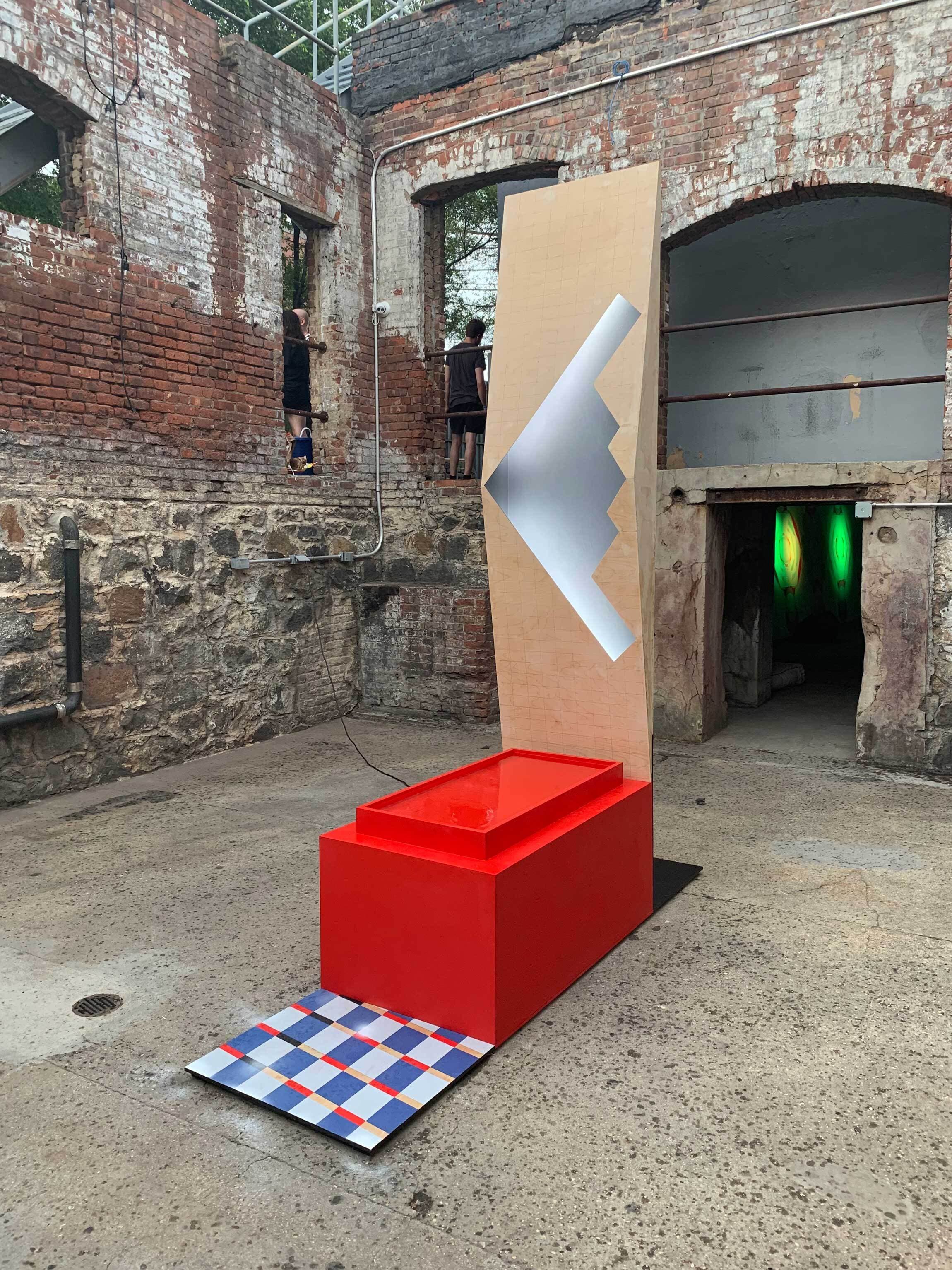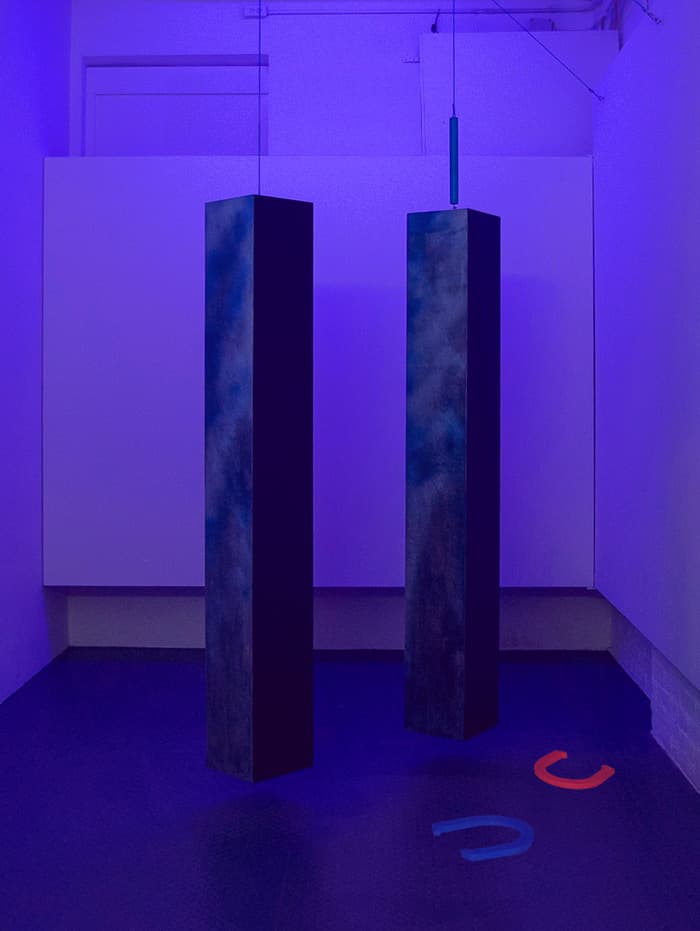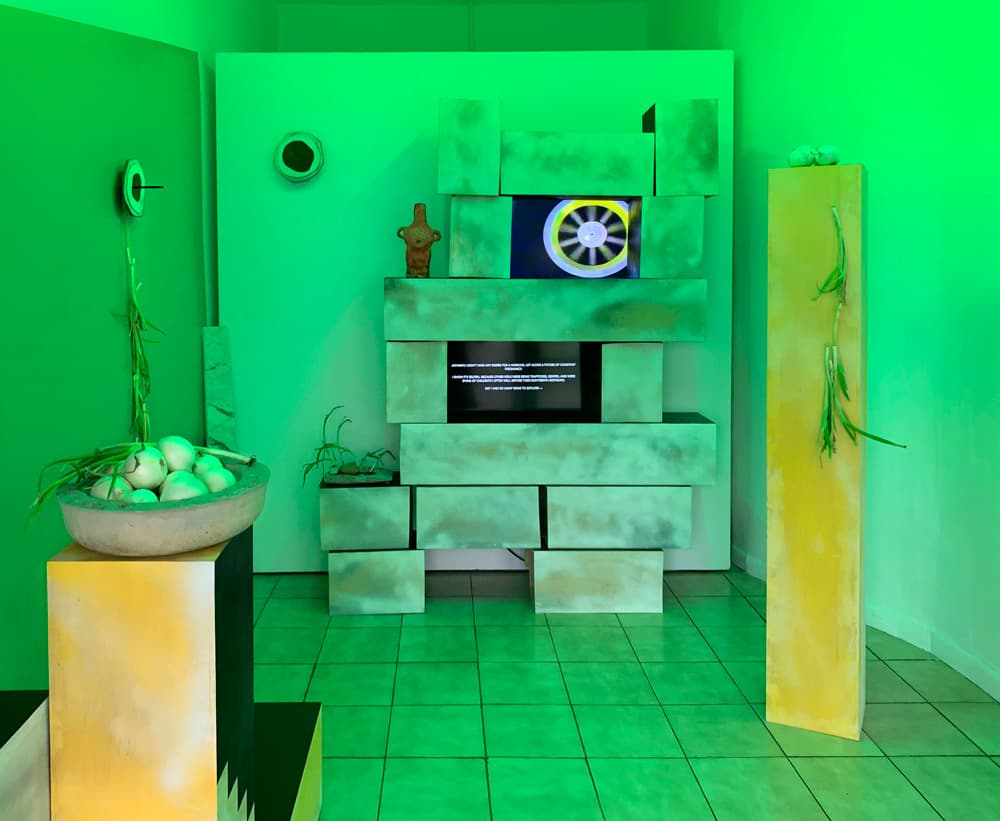Published September 19, 2022
Healing Sculptures, Traveling Time: A Conversation with Leah Dixon
LEAH DIXON (New York, NY) is a multidisciplinary artist creating sculptures and spatial interventions that address spaces where bodies and architecture collide. Her handmade and highly formal, often participatory works deal with communal geometry, conflict, and propaganda. She has exhibited nationally and internationally — including exhibitions at guadalajara90210 Gallery in Mexico City and Guadalajara, The Austrian Cultural Forum in Berlin, The Goethe Institute New York, Edel Assanti Gallery in London, DOWNTOWN 2021 with Gordon Robichaux Gallery New York, The Foundation of Contemporary Arts at Greene Naftali New York, GLORIA’S New York, Parque Galería Mexico City, The Nicaraguan Biennial of Contemporary Art, and many others. She has an upcoming solo exhibition at BOMBON Projects in Barcelona. She is the co-founder, designer, and director of BEVERLY’S. Her work has been reviewed widely, and she has taught and lectured at universities across the US and Europe. Dixon received an BFA from The Ohio State University, an MFA from The School of Visual Arts, attended The Skowhegan School of Painting and Sculpture, and completed a recent teaching fellowship in Sculpture at New Mexico State University.

I want to start this conversation with the concept of exceptionalism, which is something that I often argue your work both skewers and dissects. I'm curious what exceptionalism means to you.
LD: I've actually been thinking about this lately. In an American context, exceptionalism to me is a type of “hopefulness,” which is really central to my practice and something I implicate myself in. It's this attitude of, "Yes, I can do that. Yes, I will do that. I'll do it all! I don't know how, but I'll find a way."
This hopefulness is an exceptional quality about being an American—the can-do attitude. But we also have that on a macro scale as a nation state. We can change the policies and democratic processes of other nations. We can kill people in an airstrike in a helpful or hurtful way. We can send our military in after a natural disaster with 22nd century technology. This exceptionalism is synonymous with hope, but it ends up bordering on often violent delusion.
Before the pandemic, I was spending a lot of time in Berlin. And at times when German friends would tell me a story, I would respond with, "Oh yeah, totally. I hear you. Something similar happened to me too. Have you ever done this? Do you know this person?” One time someone replied saying, "It's so interesting that Americans think that we have to agree in order to hear each other." It’s so true, especially with my Midwestern way of processing things.
We try to find middle ground but end up creating a false equivalent. I think it comes from a really generous place of wanting to connect, but not everyone wants to be connected in that way.
At the same time, it may also be an extrapolated form of growing up in a hyper-multicultural society. We’re constantly trying to reach common ground, when most of the time it comes off clunky and sometimes aggressive. It’s not unrelated to a macro scale where the United States constantly intervenes across boundaries with sometimes deadly consequences.
Images have, for the most part, failed us. We have a hard time caring anymore…that’s why it’s important to me to make sculptures about these topics. Making sculpture is real time problem solving in space, not on a screen.
How do you think this American exceptionalism functions differently in other countries?
LD: Here’s an example. Since we are talking about my time in Berlin, when I proposed an idea to a Northern European colleague of mine there, they would sometimes say, "No, I don't think that's possible." I would, like, clutch my pearls. “That's not possible? Everything is possible! How can you say that?”
It ultimately comes down to different boundaries and levels of need. That “where there’s a will, there’s a way” philosophy can force somebody to overstep boundaries even by proxy, because that mentality gets translated to, "I'll make this happen no matter what." It’s both inspiring and terrifying. We can even see that reflected in the American military. We literally overstep our own boundaries—our actual borders. And of course, every armed situation is nuanced and on wildly different scales. But my work reflects and investigates this interest in top-down ideologies and cultural transmissions. I try to make these things take actual shape.
Using sculpture requires playing with scale and a triangulated viewing experience. It creates space for people to move around and go inside of an experience when we’re constantly looking at flat, 2D images. Images have, for the most part, failed us. We have a hard time caring anymore. It's a linear relationship rather than a triangulated one. That's why it's important to me to make sculptures about these topics. Making sculpture is real time problem solving in space, not on a screen.

I think a lot about toys like Erector sets and LEGOs, which are relatively naive forms of architecture. Their naïveté embodies this full of possibility psychology that Americans are so individually empowered. But as a maker, I am empowered. I have the agency to play with monuments. I can reconfigure systems of belief, put there by larger-than-life institutions, to break them down and show that we can touch them. What if we can manipulate them back and play a game with them?
That’s also why I make work that is participatory. I was just reading this interview by the sculptor Carol Bove. She was talking about children’s toys, saying along the lines of, "You give a kid a bubble gun or a Super Soaker, and they're freaking out for 10 minutes then forget it. But if you give them a doctor's kit, they’re able to use it as a tool to replay the drama of their own lives. And they take it with them wherever they go.” I like that idea of using sculpture as blocks, where they can be reconfigured, chopped up, and remade, because it's just like building the doctor's kit in my mind. It's a tool set that's endlessly capable of being reconfigured and therefore empowering to the players, because they can always invent a new way to play.
I want to locate these ideas in a specific work, such as TWIN TOWERS HORSESHOE TOSS. Can you walk me through when and how the piece was made?
LD: I've made three fully finished and exhibited versions of that piece from 2017-2021. It’s been both TWIN TOWERS HORSESHOE TOSS and TWIN TOWERS RING TOSS, where each version is slightly different based on its context.
My high school mascot growing up in Southern Ohio was a cowboy, so I grew up with a lot of images of horseshoes. TWIN TOWERS HORSESHOE TOSS consists of two towers made of wood, paint, and plastic horseshoes. The two towers are my exact body height, and depending on the iteration, they're either hanging from the ceiling or sitting on the floor. I cut, join, sand, and surface treat them all by handSince they’re my exact size, I have to hug them to pick them up, lay them down, move them, or rearrange them. It's a very intimate, human-scaled process. And as they get exhibited and used, they sometimes get scuffed and slightly dented, so I then have to heal them. They’re constantly being touched.
The participants can throw the horseshoes or rings at the spire on one of the towers. The horse shoes or rings are color coded if the viewers decide to team up and play the game. Whoever gets the most horseshoes or rings on the spire wins.
In all of the iterations where I have shown these works, there is always at least one group who turns the toss game into a betting opportunity. As they gear up to play, they throw dollars down on the ground as a bet—winner takes all. They end up embodying a narrative of symbolic tragedy just by playing a common backyard game.
That must be pretty emotionally challenging for some people to watch.
LD: Yeah. To me, the Twin Towers (World Trade Center) are these monuments to both American aspiration and dominance. They provide the space to talk about our national histories, media, leisure, and how we construct our own relationship to tragedy or even humor.
I moved to New York just a few years after 9/11. That tragedy defined so much of my early time in the city, being surrounded by untold stories in the shadow of a fallen monument. I always think of this idea that architecture failed at the exact moment I became an adult. We assume that iconic buildings are static institutions, but they’re fallible, human, and failing all the time.
It's important to consider these untouchable emotional monuments within our nationalist narrative as parts of our own personal stories that we can play with. It’s an American construction that history and distance are synonymous. History is as close as our imaginations are big.
Do people react differently based on where you show it? I’m wondering if you run into people reacting negatively, too.
LD: The work tends to bring up really personal experiences no matter the location. It’s scary to wade into, but I believe being scared is OK. I've shown a version in Mexico City, which was my favorite place to show it. So many viewers were excited when they saw it and wanted to talk to me about it unprompted. Some would say, “Thank you so much for letting us play with this, because the Twin Towers are positioned as an United States narrative, but 9/11 changed our lives in Mexico too in terms of border relations, immigration, and being seen as others."
I'm actually the most scared to show it in New York, honestly. Some very Gen Zers have said to me, "Why are millennials so obsessed with 9/11?" These pieces really mark my age in a vulnerable way. People my age experienced their 20s alongside the wars in Iraq and Afghanistan. It was a brand new era of complete media proliferation and an onslaught of violent imagery. But as the media continues to vomit them out, people pay less critical attention to them. That’s why images have failed us. They’re manipulating us to be complacent in real time.
On the other hand, when someone expresses concern, confusion, or frustration with the piece, I discuss the experience of living and working in Lower Manhattan over these past two decades. I witnessed the neighborhood turn from a cemetery to a construction zone to a real estate grab. The towers housed so many New Yorkers—moguls, assistants, maintenance workers, restaurant workers, teachers, students. And while the new building reflects some of that diversity again, I can’t help but see how the wealthy elite turned a profit in the meantime. It’s like it was a game to them. Back then, you could walk down Canal Street and see snow globes of Lower Manhattan for sale, but instead of snow, you'd shake the globes and gray ashes would fall. 9/11 has been used to degrade and contort morality since the moment it happened. It was impossible not to touch, and be touched, by the topic—for better or for worse.
It took me over ten years from that point to find the courage to say to myself that the Twin Towers are an origin story of my generation. They’re not just this emblematic moment in American history. They were like Adam and Eve—fallen lovers that mark an ending and a beginning. They were human. And I aged alongside their shadow.
American monuments often memorialize events as architectures of the past. The argument that we can’t talk about these things in raw or even humorous ways divorces us from our history and our lived humanity. Artists, collectors, and others in the art world are not separate from these experiences. We embody them, and we can manipulate them ever so slightly with the tools that we have. Sculpture has the ability to narrow the gap, and I think these pieces try to do that.
And by the way, the art world plays a part in this too. We’re completely within the luxury sales and acquisitions world of Lower Manhattan’s real estate. These complexities are central to why I want to engage in this community, comment on it, and play with it. Inequity, and subsequent creative attempts at justice, are running through every vein of what we do. If we don’t discuss it, we let it go unquestioned.

I’m curious about the materials you often choose—wood, steel, and spray paint. Why are you drawn to types of materials most often found in practices outside of art, like architecture, urban planning, and large-scale construction?
LD: I love construction materials because I have the ability to move them, cut them, and manipulate them myself. It allows me to be very nimble. I don’t require a foundry or huge welding studio. I can buy them in virtually any city. 123 Chrystie Hardware in Chinatown is where I get most of my materials.
Shout out to 123 Chrystie Hardware.
Yeah! I love them. And for the spray paint, at least conceptually, I go back to the failure of 2D images. Spray paint creates a pixelation with its dots of paint. When you look up close, it looks like a photograph, because it creates a pixelated space. It messes with the figure ground, almost like it's a DIY printing technique, and builds up a grainy atmosphere similar to a photo but on top of a three-dimensional figure. I have an aversion to thinking about graffiti, but in a weird way I am actually making graffiti on my own works—it's just diffused and atmospheric.
You’re using spray paint as a material to paint, not a material to tag.
LD: Totally. Living in lower Manhattan for almost two decades, I’m constantly looking at glass and seeing the sky reflected in it back to me. Spray paint on wood reflects in a similar way. It's also a quick and easy surface treatment for the wood, because the wood needs to be sealed. The paint can heal sculptures, too. I'm constantly moving them around. They accumulate dings and scrapes, so I’m constantly healing them with filler and spray paint. It ends up slightly changing the piece too. And that change will be a roadmap to further push the piece.
I love the term that you're using: “healing” the sculpture. It's as if you're treating it like a person, or something that lives and breathes.
LD: It's an empowering way to think about monoliths and architecture as bodies that can be broken and healed. Almost all of my sculptures have some component that’s exactly my body height. They are a sort of avatar of myself, because that's what we’re doing as sculptors. We’re just constantly making ourselves. We’re making our bodies—not our image, which is a huge distinction that I am interested in.

The Invention of the Wheel was shown at Gloria's, and curated by Azikiwe Mohammed. That piece is another example of how your work points to a specific point in human history and unpacks its socioeconomic implications. What drew you to discuss a point in time that, in contrast to 9/11, is way further in the past?
LD: I've heard a number of people tell this story of the true first tool. We assume it's a hammer or a hitting device—a “male” device. But the question is, how did they carry it? They must have needed a pocket or a basket—a female device. Which came first? I love that we'll never know.
One crazy caffeine-fueled morning in Berlin, I was thinking about this idea and started writing this story about a time traveling girl. Maybe she's me, maybe she's not. She grew up on an onion farm at the dawn of agriculture as humans were turning onion grass into onions. Because she smelled like onions, when she was no longer a child, she wasn’t basically paired with a man like all of the other girls. No one wanted to take her. She was kind of a pariah, but she was free.
This freedom allowed her to become an inventor. She needed to provide for her parents and herself—and when contemplating how to maximize productivity, she knew she needed to be able to move more onions to market. So she invents the wheel, and then the axel and a cart. She begins to time travel with the invention. She time travels into the future to Mesoamerica, and then to New York at the millennium, and to 9/11. That’s when she is overcome with thousands of years of knowledge that a good invention has so many possibilities that it will at some point spiral out of control. She had unknowingly invented global transportation, and therefore modern warfare.
Do you think part of an artist's job is to complicate moments like these in history?
LD: I think part of my job feels like that. History is just labor. People did stuff. Who were those people? And what labor is not being told? Who is silenced? We’re blessed with, or stuck with, a lot of people’s things. It's also interesting to think of this in terms of being a woman who builds things.
Why should someone reconsider or rethink stories and histories they've been told?
LD: Our built environment is so complex. We have arts institutions that tell us to stop and look at certain things. But these things are no more complicated nor important than a bodega, and we aren’t told to stop and look at a bodega. We're brainwashed into believing that we're looking at the “right” and most “important” things, and it's completely arbitrary if you think about the scale of the world outside. Thinking of all the things that we don't notice, or that we can’t see, is a fertile place to build empathy and ask questions.
Testudo is always looking for more voices to write with us about the art world. If you’d like to pitch an article, please see our pitch guide for more information!